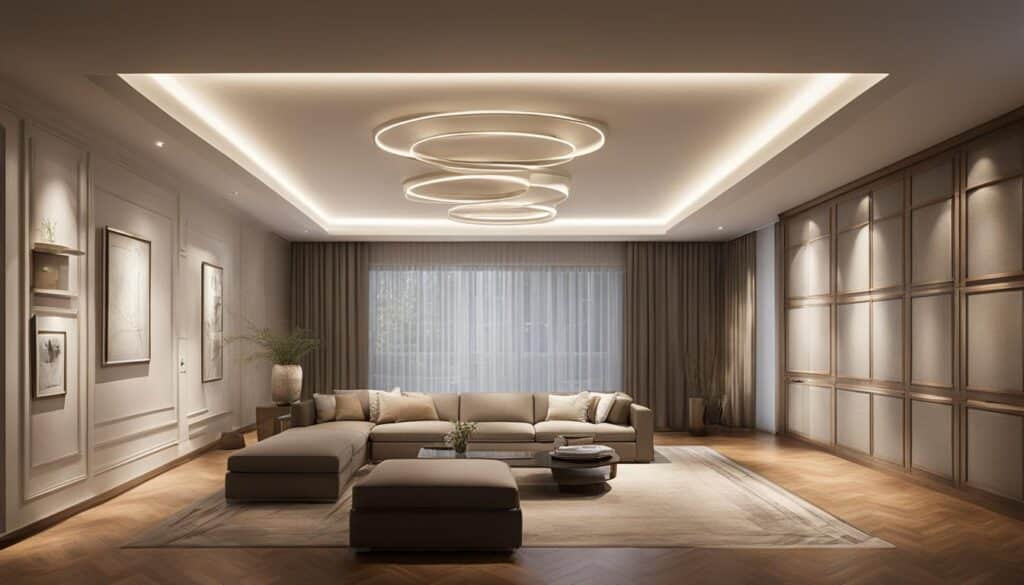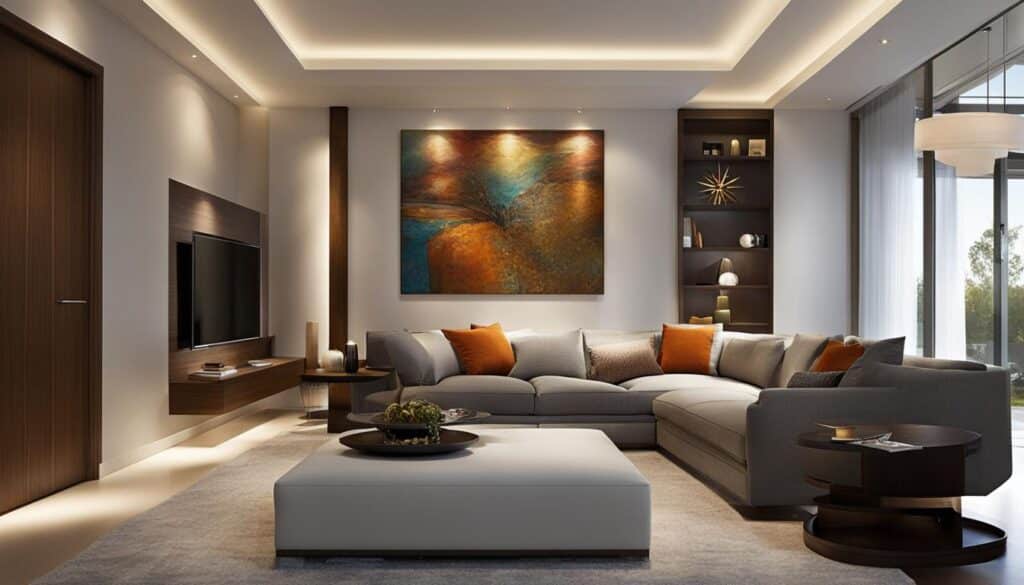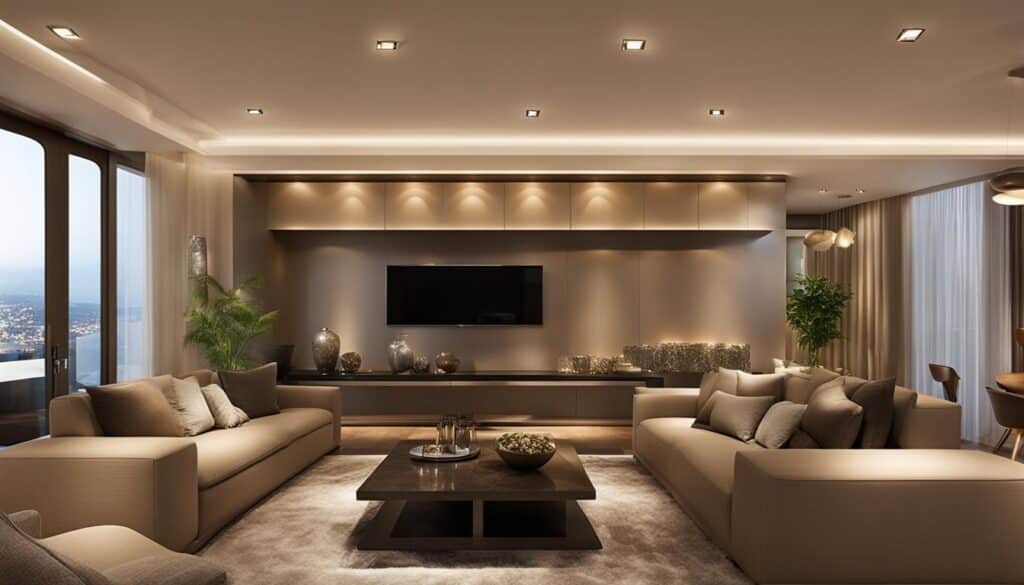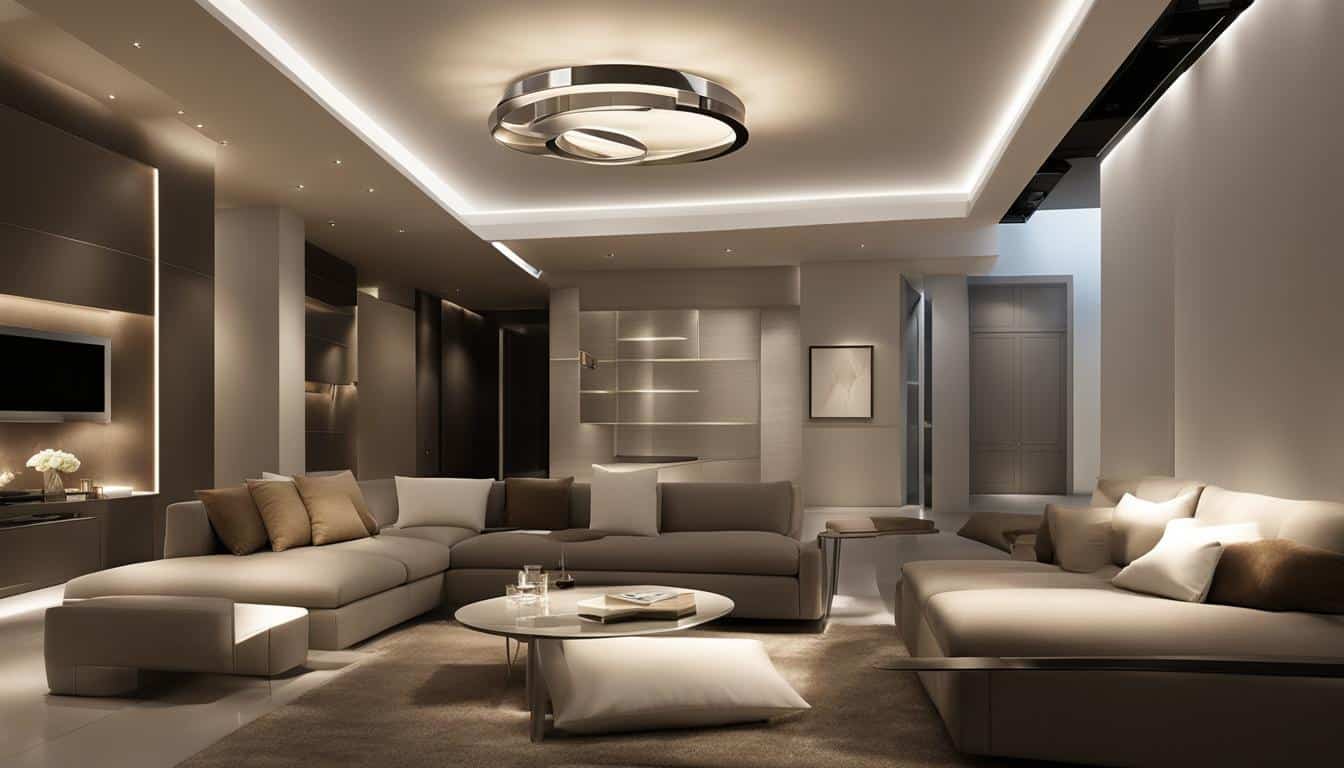As a homeowner, I’ve learned that the right lighting can completely transform the ambiance and functionality of a room. One particularly versatile option is recessed lighting, which can be tailored to create anything from a cozy nook to a vibrant entertainment space. If you’re looking for guidance on crafting a flawless recessed lighting layout, you’ve come to the right place. I’ve put together this comprehensive guide to help you every step of the way, from setting your lighting goals to selecting the perfect fixtures and bulbs.
Key Takeaways
- Define your lighting goals to influence layout style and calculations
- Choose between ambient, task, or accent lighting based on the room’s purpose
- Apply the ‘Ceiling Height Formula’ for optimal light placement
- Ensure even light distribution to avoid shadow formation
- Select appropriate trim styles, bulbs, and fixtures to complement your design vision
- Consider integrating dimmers for additional lighting control and energy efficiency
- Sketch your room on graph paper to serve as a foundational guide for fixture placement
Embracing the Beauty and Functionality of Recessed Lighting
Recessed lighting, installed in the hollow of a ceiling, offers tremendous functional and aesthetic value when laid out correctly. It boosts the visual appeal of a space while ensuring functionality. The type of recessed lighting chosen—be it ambient to light up an entire room; accent to feature art or architectural details; or task lighting for workspaces—will require different layout approaches to optimize the room’s appearance and enhance its functionality.
Understanding Recessed Lighting and Its Impact on Your Space
When selecting the appropriate recessed lighting for your space, it’s crucial to take these three main types into account:
- Ambient lighting: provides a comfortable glow across the entire room.
- Accent lighting: emphasizes specific features or artwork, adding focus to architectural details.
- Task lighting: heightens visibility for workspaces, such as under kitchen cabinets or above countertops.
Each type of recessed lighting serves a distinct purpose, delivering practical solutions while enhancing a space’s overall appearance. A well-executed layout will continue to reward the space with remarkable visual appeal and functional benefits.
The Vital Role of Layout in Recessed Lighting Design
The importance of a well-thought-out recessed lighting layout cannot be overstated, as it significantly influences the perceived size and ambiance of a space. A meticulous layout enhances room features, prevents shadows, and contributes to an inviting atmosphere. By avoiding a layout resembling an ‘airport runway,’ a balance can be achieved through strategic placement alongside other lighting types like floor lamps or pendant fixtures.
“The best-laid plans of recessed lighting often go awry if the layout is an afterthought. To unlock the true potential of these versatile fixtures, invest time in planning a precise layout that harmonizes the space and captures the spirit of the room.”
In conclusion, understanding the different types of recessed lighting, their impact on your space, and the integral role of layout in the recessed lighting design process is essential for creating a captivating and functional environment. Diligent planning, experimenting with various arrangements, and choosing the correct type of recessed lighting will transform any room into a comfortable, well-lit haven that adds life and beauty to your home.
Establishing Your Lighting Goals: The First Step to a Flawless Design
Commencing the lighting design process requires identifying the primary goal for your space. The key is to decide between ambient, task, or accent lighting, which serve distinct purposes and contribute to a room’s appeal and functionality. This goal-setting stage steers the layout calculations and lighting placement strategies to ensure the intended effect is achieved.
“The art of lighting lies in understanding the role of light in enhancing the ambiance and practicality of a space.”
Ambient lighting, task lighting, and accent lighting create different atmospheres and cater to varying needs. Let’s delve deeper into each of these types to aid in your decision-making process:
Deciding Between Ambient, Task, or Accent Lighting
- Ambient Lighting: Also known as general lighting, it provides a comfortable glow that illuminates the entire room evenly. This type of lighting ensures sufficient brightness for everyday tasks and contributes to a cozy, warm atmosphere.
- Task Lighting: As the name suggests, task lighting focuses on specific areas where activities such as reading, cooking, or working take place. It offers localized illumination for greater visibility, enhancing functionality in work zones like under kitchen cabinets or above office desks.
- Accent Lighting: This type of lighting is used to emphasize specific aspects of a room, such as artwork, architectural features, or particular displays. It creates visual interest and helps draw attention to your prized possessions or unique focal points.
Understanding the intended purpose of your recessed lighting layout helps you decide which type of lighting to incorporate. Once the desired lighting effect is clear and aligned with your objectives, additional decisions such as the number and types of fixtures, optimal spacing, and wattage can be tailored to achieve a harmonious design.

The Blueprint to Success: Sketching Your Recessed Lighting Plan
One of the most crucial phases in designing a recessed lighting layout is creating a blueprint of the room on graph paper. The sketch provides an accurate representation of the room by including measurements and a scale to determine the actual dimensions. This detailed illustration serves as a foundational guide for fixture placement and allows you to experiment with various patterns without going through the trouble of repeated measurements.
- Accurately measure the room’s dimensions;
- Mark the location of the existing light fixtures and switches;
- Include any significant architectural features, such as columns or fireplaces;
- Consider the layout of the furniture and how it might impact lighting;
- Note the position of windows and the direction of natural light.
Having multiple copies of your blueprint will provide you with the flexibility to experiment with different layouts. You can even invite friends or family members to offer their perspectives by providing them with a copy of your sketch. Their input could prove valuable during your decision-making process.
Remember: taking the time to create a detailed blueprint will lay the groundwork for a successful recessed lighting layout that fulfills your desired ambience and functionality needs.
Once you’ve sketched your blueprint, you can begin to strategize on your recessed lighting layout, considering factors such as fixture spacing, ceiling height, and your specific lighting goals. From there, you can make thoughtful decisions about the type of fixtures, trim styles, and bulbs that will best complement your room and design vision.
In conclusion, a well-executed blueprint is a stepping stone to success in your recessed lighting layout journey. Don’t be afraid to dive into the details, as meticulous planning will ultimately pay off, helping you create a stunning and functional space that meets your unique lighting needs.
Illumination Equation: Simple Formulas for Perfect Lighting Balance

A key to achieving a balanced lighting scheme is the ‘Ceiling Height Formula,’ where the ceiling height is halved to determine the spacing between lights. This basic guideline assists in creating an evenly lit space but may be adjusted based on bulb wattage, decor brightness, and room dimensions to attain the desired illumination level.
The Ceiling Height Formula for Optimal Light Placement
The Ceiling Height Formula is a simple rule that dictates:
Spacing between lights = Ceiling height ÷ 2
For example, if your ceiling height is 10 feet, you would space your lights 5 feet apart. This not only ensures optimal lighting distribution but also creates a coherent and visually appealing layout. However, this formula is not set in stone, and adjustments can be made based on your specific lighting needs and preferences.
Determining the Ideal Spacing Based on Room Dimensions and Wattage
For ambient lighting, the spacing between fixtures is derived by dividing the room length by the number of lights in a row and replicating for width. Task lighting near walls has different criteria, while accent lighting is dictated by fixture proximity to the wall, which varies based on adjustability. Calculating wattage requirements and considering room dimensions are critical steps towards an optimally lit room.
| Lighting Type | Formula |
|---|---|
| Ambient Lighting | (Length ÷ Lights in a row) x (Width ÷ Lights in a column) |
| Task Lighting | Varies based on workspaces and activity areas |
| Accent Lighting | Distance from the wall depends on fixture adjustability |
It is essential to keep in mind that these formulas serve as a starting point. The key to achieving a perfectly balanced and illuminated room lies in making necessary adjustments based on factors such as bulb wattage, room size, and the brightness of your decor. The result is a harmonious and well-lit space that meets your practical and aesthetic requirements.
Leveraging Recessed Lighting for Distinct Room Ambiances
To harness the full potential of recessed lighting in creating varied room ambiances, it is essential to understand the influence of light positioning relative to room features and the desired illumination effect. The selection of light intensity and placement plays a pivotal role in crafting atmospheres, whether serene or vibrant, through carefully configured layouts.
To illustrate these principles, consider the following examples:
- Ambient lighting is ideal for a cozy living room, where even light distribution provides a warm and inviting ambiance. Placing lights around the perimeter and in the center of the room ensures ample brightness without overwhelming the space.
- Accent lighting highlights specific features like artwork or architectural details. Positioning lights in close proximity to or directly above the desired focal point will draw attention and create visual interest.
- Task lighting caters to specific activities like reading or cooking, requiring localized, intense light to enhance visibility. Placing task lighting over desks, kitchen counters, or workstations ensures optimal illumination for these activities.
The success of your recessed lighting layout will ultimately depend on the correct application of these principles while taking into account the unique features and goals of your space. Consider these additional tips to optimize your lighting design:
- Experiment with light beam angles to achieve a variety of effects, from focused spotlights to wide floodlights.
- Choose light color temperature based on the desired ambiance: warmer temperatures for cozy, intimate areas and cooler temperatures for clean, bright spaces.
- Combine various types of fixtures, such as swivel or adjustable, to achieve dynamic lighting solutions that adapt to different scenarios and occasions.
“A well-planned recessed lighting layout can elevate the ambiance and functionality of any room, transforming it into a visually stunning and inviting space.”
In conclusion, creating distinct room ambiances using recessed lighting requires proper planning, attention to detail, and thoughtful execution. By taking into account the desired ambiance, fixture positioning, and light intensity, you can achieve a beautiful and harmonious balance in your living or workspace.
Finessing the Details: Trim Styles and Dimmers in Recessed Lighting
When designing your recessed lighting layout, paying attention to the trim styles and incorporating dimmers can significantly elevate the overall aesthetics and functionality of the space. This section will highlight the importance of choosing the right trim styles and integrating dimmers to create dynamic lighting control.
The Importance of Trim Styles in Complementing Room Aesthetics
Selecting a trim style for your recessed lighting should seamlessly blend with your room’s decor, enhancing its overall appearance. A well-thought-out choice in trim style helps define the room’s ambiance and lends a polished look to the finished design. Some popular trim styles include:
- Baffle trims – Designed to reduce glare, these trims have ribbed interiors and are ideal for living rooms or bedrooms.
- Reflector trims – Featuring a smooth, mirrored finish, these trims increase light output and are perfect for spaces requiring bright lighting, such as kitchens or work areas.
- Adjustable trims – Offering directional lighting, these versatile trims enable you to change the direction of the light, making them ideal for accent or task lighting applications.
- Decorative trims – From simplistic designs to ornate patterns, decorative trims can add a touch of elegance by complementing the room’s theme or highlighting architectural elements.
The style and finish of your trim should harmoniously blend with your room’s design and color scheme. For a versatile option, consider a minimalist alabaster hue, or opt for a stamped metal fixture for an elegant touch.

Integrating Dimmers for Dynamic Lighting Control
Incorporating dimmers into your recessed lighting layouts offers the flexibility to adjust light intensity according to your mood or the occasion. Dimmers provide you with granular control over your lighting environment, allowing you to create customized ambiances that suit various activities and events. In addition to aesthetic benefits, dimmers can also:
- Save energy by reducing power consumption when lights are dimmed
- Prolong bulb lifespan by minimizing the workloads of the lightbulbs
- Enhance the user experience by providing personalized control over the room’s atmosphere
In summary, by selecting complementary trim styles and integrating dimmers into your recessed lighting layout, you can create a visually appealing and functional space tailored to your needs and preferences.
The Shadow Factor: Ensuring Even Light Distribution
As you embark on developing your recessed lighting layout, one essential aspect to consider is the prevention of forming shadows, particularly in room corners. Shadows can make a space feel smaller and more cramped, negatively impacting the overall ambiance and perceived value of a room. Moreover, dark spots and uneven light distribution may result in inadequate illumination and reduced functionality.
By carefully following spacing guidelines, you can maintain the feeling of spaciousness and preserve a room’s ceiling height. Below are some essential tips on how to distribute light evenly and avoid shadows in your recessed lighting layout:
- Adhere to the ceiling height formula: As mentioned earlier, using the ceiling height divided by two as a yardstick for spacing between light fixtures can prevent shadows and uneven illumination.
- Ensure corner brightness: Corners tend to be the darkest areas of a room. Position accent and ambient lighting close enough to the corners to prevent the formation of shadows and maintain a perception of spaciousness.
- Consider wall wash recessed lighting: Wall wash lighting is designed to project light onto a wide surface area, reducing shadows and creating a more even glow across a room’s vertical surfaces.
- Supplement recessed lighting with other light sources: Using a combination of lighting types, such as floor lamps, table lamps, or pendants, can help fill in any remaining shadows and provide additional depth to your space.
Remember, an even light distribution not only maintains the feeling of spaciousness but also enhances a room’s ambiance and overall perceived value.
In closing, designing an optimal recessed lighting layout requires careful planning and adherence to spacing guidelines. By considering the shadow factor and ensuring even light distribution, you nurture an inviting atmosphere that elevates the allure and value of your space.
Accessorizing Your Lighting: The Finishing Touches for Refined Design
As the final step to achieve a cohesive and refined lighting concept, selecting appropriate bulbs and fixtures is essential. It is crucial to pay attention to the aspects of energy efficiency, light quality, and suitability for specific room functions and ceiling heights. This strategic approach to bulb and fixture selection shapes the final ambiance and functionality of the space.
Selecting the Right Bulbs and Fixtures for Your Design Vision
Advancements in lighting technology have provided a range of efficient and versatile bulbs to cater to various design preferences. To help you choose the ideal bulbs and fixtures for your recessed lighting layout, consider the following options:
- LED Bulbs: Offering energy efficiency, long-lasting performance, and minimal heat production, LED bulbs pose an eco-friendly and cost-effective choice for homeowners.
- Halogen Bulbs: Known for their high-quality white light, halogen bulbs enhance the color accuracy and vibrancy of illuminated spaces.
- Compact Fluorescent Lamps (CFLs): These bulbs provide substantial energy savings compared to incandescent bulbs and come in various shapes and sizes to fit different recessed lighting fixtures.

When selecting fixtures, it is vital to keep the ceiling height and room function in mind, as this will influence the light spread and intensity. The following table showcases some key characteristics for various fixture types and their suitability:
| Fixture Type | Features | Best for |
|---|---|---|
| Baffle Trim | It minimizes glare by absorbing excess light using soft, ribbed textures. | Living rooms, bedrooms, and other spaces requiring soft, diffused lighting. |
| Reflector Trim | Designed with a mirrored finish to redirect and intensify light output. | Task and accent lighting setups, such as kitchen countertops or artwork display. |
| Adjustable/Gimbal Trim | Allows for tilting and rotation of the light direction, providing precise control. | Areas requiring directional lighting, including accent and task lighting scenarios. |
| Shower Trim | Typically uses a frosted lens to protect the bulb from moisture without compromising light output. | Bathrooms and wet locations where moisture resistance is essential. |
With careful consideration of your design vision and attention to the elements of energy efficiency, lighting quality, and functional suitability, your recessed lighting layout will achieve a refined and harmonious blend of style and substance.
Mastering Recessed Lighting Layout: A Comprehensive Guide
Designing an effective recessed lighting layout requires a thorough understanding of the type of illumination desired, along with accurate room measurements and sketches. Proper fixture spacing based on ceiling height and room function ensures an evenly lit space that maximizes both aesthetics and utility. With this knowledge under your belt, you can confidently embark on the journey to create a beautifully illuminated and inviting space in your home.
Selection of trim styles should complement the overall room decor, while integrating dimmers allows you to control the ambiance based on mood or occasion. By taking into account these details, you’ll be better equipped to create a cohesive, refined lighting concept in any room. Keep in mind that even light distribution is crucial in preventing shadow formation, particularly in corners, which helps maintain a sense of spaciousness and ceiling height.
Lastly, choosing the right bulbs and fixtures is essential for successfully bringing your design vision to life. Options such as energy-efficient LEDs or high-quality white halogen lights, influenced by factors like ceiling height and room function, can significantly impact the final ambiance and functionality of your space. With this comprehensive guide, you are well-prepared to master your recessed lighting layout, adding exceptional beauty and practicality to any room in your home.
FAQ
What is the difference between ambient, task, and accent lighting?
Ambient lighting provides a general, comfortable glow for a room. Task lighting enhances functionality in work areas, such as kitchen countertops or office desks. Accent lighting emphasizes specific features or artwork in a space, creating focal points.
How do I determine the ideal spacing between recessed lights based on my ceiling height?
Use the ‘Ceiling Height Formula,’ where the ceiling height is halved to calculate the spacing between lights. For example, with a 10-foot ceiling, the lights should be placed approximately five feet apart. However, this may be adjusted depending on factors like wattage, room dimensions, and decor brightness.
How can I create different ambiances in a room using recessed lighting?
The ambiance can be influenced by the positioning and intensity of the recessed lights. You can also utilize dimmers for adjustable light levels and choose appropriate trim styles to complement room aesthetics.
What are some factors to consider when selecting trim styles for recessed lighting?
Trim styles should harmonize with the room’s decor and enhance its overall appearance. Consider factors like color, material, and design when choosing a trim style that fits the aesthetics and function of your space.
Why is it critical to prevent shadow formation in a recessed lighting layout?
Preventing shadows is essential as they can make a space feel smaller and negatively impact the ambiance. Ensuring even light distribution helps avoid shadows and maintain the feeling of spaciousness and ceiling height, key factors in a room’s appeal and perceived value.
What factors should I consider when selecting bulbs and fixtures for my recessed lighting layout?
Factors to consider include energy efficiency (LED options), light quality (halogen bulbs for high-quality white light), ceiling height, and the function of the room. The right combination of bulbs and fixtures will shape the final ambiance and functionality of the space.

